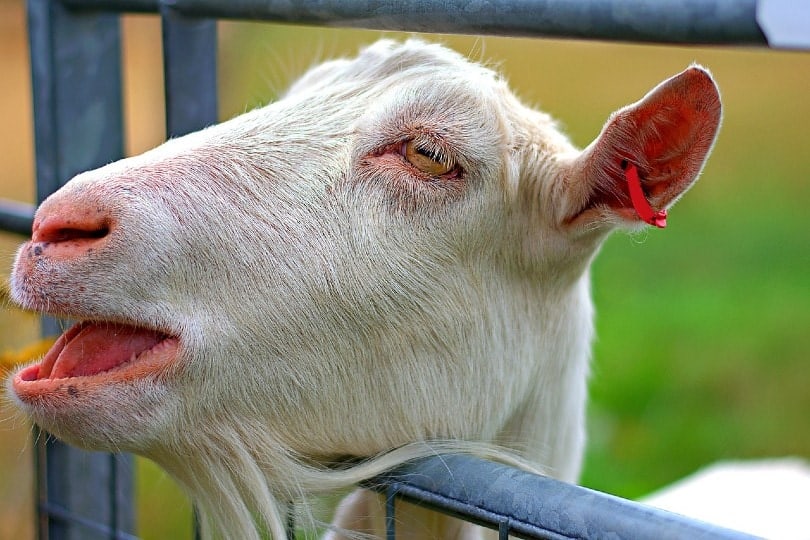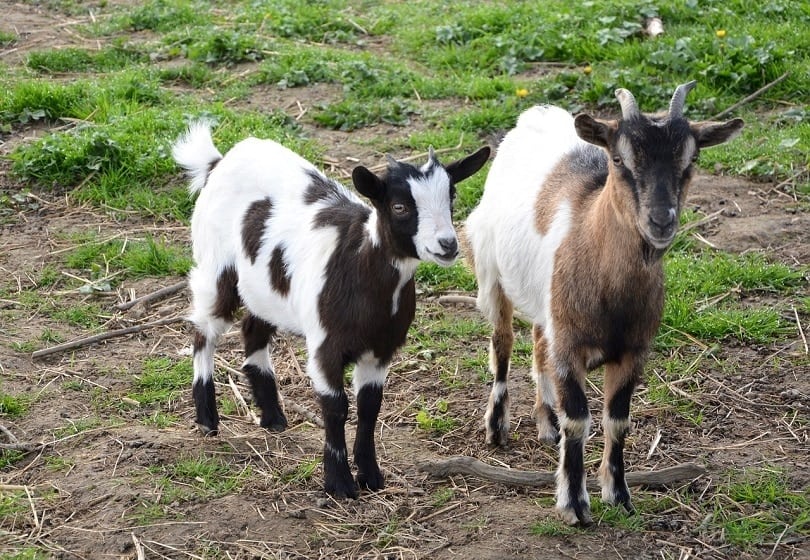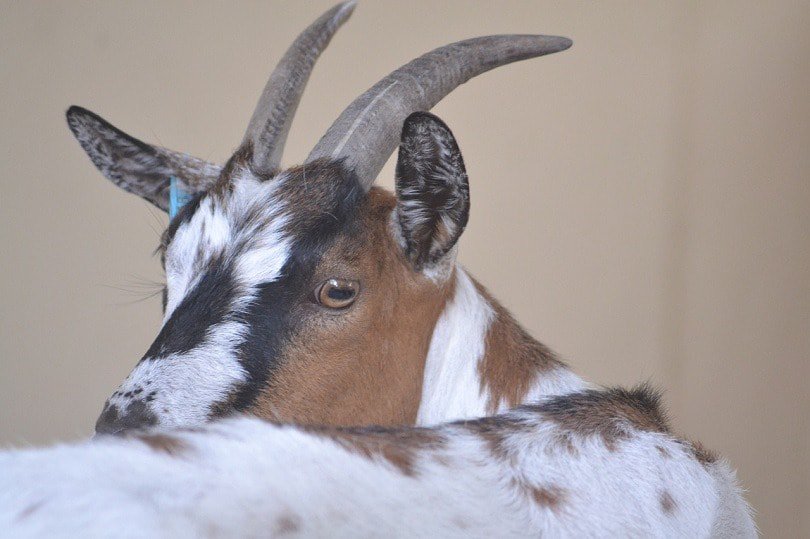Recognizing when your goat is in heat will help you when you decide to breed them. Your female goat’s heat cycle is short and there’s only a brief period when she’s willing to let a buck mount her. Noticing the signs will help ensure that you don’t miss the chance.
We put together this guide to help teach you how often goats go into heat. Usually, they are seasonal breeders, which means most goats go into heat in one part of the year. We also bring you the list of the common signs to look for to make sure the breeding season is successful.

How Often Do Goats Go Into Heat?
Many goats are seasonal breeders, which means they only go into heat during one part of the year, usually from September to February. Does will have several heat cycles during this period that occur every 18–22 days.
Your doe will only be in heat for 48–72 hours, however, and there’s an even shorter amount of time when she’ll be willing to let a buck mount her.
The 10 Signs Your Goat Is in Heat
Not all goats exhibit all these signs when they’re in heat; some only show a few, while others show many. If you’re not sure your goat is in heat but they’re showing signs of strange behavior, make a note on your calendar. In 18–22 days, if the behavior repeats, your goat is likely to be in her estrus period and ready for breeding. Here are the signs to look for:
1. Behavior Change
Knowing when your goat is in heat depends on how well you know your doe. Since goats are individuals with rambunctious personalities, heat can affect them in numerous different ways.
Behavior changes are the most obvious. Your doe might be grouchier than usual or friendly when they’re usually aloof. They might even act more buck-like themselves and mount the other female goats that they’re penned with, especially if there isn’t a buck nearby.

2. Excessive Tail Wagging
Goats wag their tails frequently while they’re eating or playing around. Does in heat will take this to the extreme, which is known as “flagging”.
This is a sign that will persist through a goat’s entire estrus cycle and doesn’t necessarily mean she’s reached her standing heat phase.
3. Non-Stop Talking
Depending on how loud your goat is most of the time, this sign can be more obvious for some goats than others. When your goat is in heat, she may demonstrate an unusual desire to talk. While some goats don’t make much noise when they’re in heat, others use their vocals to express their interest to any nearby bucks.

4. Vaginal Discharge
This is one of the more obvious signs, particularly when the discharge makes your goat’s tail look wet or dirty. It’s also a good way of judging how far along your goat’s estrus cycle is. At the start of the 48 hours, their vaginal discharge will be clear and sticky, and it will turn a milky white toward the end.
5. Swollen Vulva
For some goats in heat, another obvious sign is that their vulva swells. It’ll also be slightly red in appearance. Paying attention to your goat’s appearance throughout the year will help you notice this change more easily.
6. Loss of Appetite
During their heat cycle, goats may do one of two things regarding their food intake. They might decrease their intake of food or refuse to eat entirely.

7. Milk Volume
When a doe is in heat, you might find that the volume of milk they produce decreases. While they might usually stand at the milking pen willingly the rest of the year, when they’re in their estrus period, you might find that they refuse to be milked at all.
8. Urinating More Often
To draw the attention of would-be suitors—namely, the buck in the next field—your doe will pee more often during her heat. Her urine will contain pheromones that tell the buck that there’s a doe in heat.
9. Reaction to Nearby Bucks or “Buck-Rags”
One of the easiest ways to tell your goat is in heat is by watching her interact with nearby bucks. Many does rub themselves against a male goat or prance around if they’re not in the standing heat phase of their cycle.
If you don’t want your goats to be in the pen together, you can rub a rag over your buck’s forehead to make a homemade “buck-rag”. Seal it in a Ziploc bag or a Tupperware container before presenting it to your doe. A doe in heat will become excited when she smells it.

10. The Buck’s Reaction
Along with watching your doe for behavior changes around the opposite sex, your buck will also react to the signs of a doe in heat. More often than not, they’ll try to draw the doe’s attention by acting in ways that humans find peculiar.
These actions vary from wagging his tongue, prancing around, lifting his upper lip, or flehmen, when smelling a doe’s urine, or even peeing on their own beard, chest, and front legs.

FAQ
If you’re a complete newbie to owning or breeding goats, you probably have many questions about the process and how often goats go into heat. We put together this list to answer a few common queries about breeding goats.
When Do Goats Go Into Heat?
The answer to this question depends on the breed of goat that you own. Some goats are seasonal breeders, while other breeds will go into heat regularly throughout the year. The age, the diet, the presence of males, and many other factors including the region where you live and the hours of sunlight during the seasons also affect the breeding cycles. In temperate regions, goats tend to be seasonal breeders, while goats living in tropical regions will go into heat throughout the year.
Seasonal Breeding Goat Breeds
- Alpine
- Lamancha
- Oberhasli
- Saanen
- Toggenburg
- Angora
Year-Round Breeding Goat Breeds
- Fainting goats
- Kinder
- Boer
- Kiko
- Nigerian Dwarf
- Spanish
- Pygmy
Note: Sometimes, Nubian goats are included in both categories because their heat cycles can be seasonal and last longer than the usual September–February period.
What Is a “Standing Heat”?
When your doe is ready for a buck to mount her, she’s entered a stage of her heat cycle known as the “standing heat.” Usually, this stage happens during the middle of your goat’s heat cycle.
The standing heat stage doesn’t last long and is bracketed by periods of disinterest, where your doe will be unwilling to let your buck mount her. By recognizing the signs and knowing when your doe is in heat, you can ensure that breeding is successful.

Can You Pen Does and Bucks Together?
It can be tempting—and easier than paying attention to the signs of your goat’s heat—to leave your buck penned with your female goats throughout the whole breeding season. In practice, though, this doesn’t work well.
If you pen your male and female goats together, a few months into the breeding season, you may find that familiarity has made your buck bored and the doe uninterested, regardless of where she is in her cycle.
Only keep your goats penned together for, at most, 45 days, about 6 weeks. Since goats go through estrus every 18–22 days, 6 weeks will cover at least two of the doe’s heat cycles and stand a chance of her being successfully bred. Any longer than 45 days, though, and you run the risk of both goats losing interest.
Here’s something interesting about goats: How Do Goats Show Affection to Each Other and Humans? (7 Signs To Look For)

Final Thoughts
Goats are either seasonal or year-round breeders, depending on their breed. Either way, their heats last 48–72 hours and recur every 18–22 days. These cycles are short and for seasonal breeding goats, only happen between September and February.
For a successful breeding season, it’s important to pay attention to your goat’s behavior and use the signs that they show to figure out when to pen your male and female goats together. Part of knowing when your doe is in heat comes down to paying attention to her mannerisms throughout the year, not just during the few days that she’ll be in her estrus period.
See also:
Featured Image Credit: violetta, Pixabay
